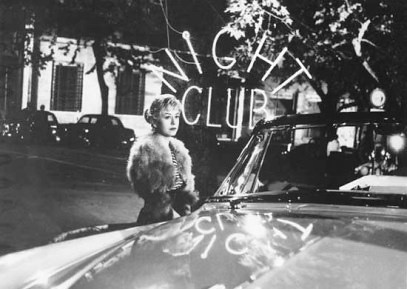 This is the last film of Fellini’s second triliogy that started with La Strada (1954) and Il Bidone (1955). A trilogy dedicated to themes of people living on the margins of society (street dancer, swindler and a prostitute) that despite their rough lives eventually experience radical life change, call it redemption.
This is the last film of Fellini’s second triliogy that started with La Strada (1954) and Il Bidone (1955). A trilogy dedicated to themes of people living on the margins of society (street dancer, swindler and a prostitute) that despite their rough lives eventually experience radical life change, call it redemption.
In this film, Fellini brings back Cabiria, the prostitute with the heart of gold played beautifully by his wife Giulietta Masina. Fellini has already presented us with the role of Cabiria in his 1952 film The White Sheik. There Cabiria is consoling poor Ivan at the piazza late at night after he lost hope of finding his wife.
After the dismal reviews both critically and in the box office for his previous film Il Bidone (1952), Fellini comes back two years later with the proposal of The Nights of Cabiria and receives the cold shoulder everywhere he turns. Practically, the film is about a life of a prostitute in Rome – a tough sell in 1950’s Italy. The film was eventually produced by the one and only – Dino de Laurentiis.
The film tells the story of Cabiria a Roman prostitute with an intricate personality. On one hand she’s the tough street-smart taking no pimp to manage her affairs, constantly bragging about her independence, owning her own home. On the other, she’s very fragile, naïve and desperately romantic who really wants to change her life.
Throughout the film Fellini shows us how swindlers take advantage of Cabiria; the film opens when she was thrown into the Tiber river after being mugged, and then another shady type named Oscar is fooling her with the illusion of a true love only to rob her of all her life savings.
Interestingly, there is one scene in the film that was just recently added since the church objected to include it in the original release. The scene is known as The Man with the Sack, showing a man with a big sack going from one cave to another, giving out food for the poor residents of these makeshift shelters. The church objection rationale is clear – that should have been the church role.
Another scene, shows Cabiria visiting a sacred place with her friends where they all pay their dues for a chance to be redeemed and have a life changing experience. After the service is over, during which Cabiria was deeply moved – there is a lovely scene where Cabiria and her friends are having a picnic and Cabiria suddenly realizes that nobody has really changed they’re all the same including the cripple who joined them.
Fellini provides us with a clear message about the role of the church that operates as a dream machine or some kind of lottery where you pay a ticket for a chance to win a better life. But as we know odds are slim. Cabiria’s friends accept that logic, but not Cabiria who sees through it all and in a way is asking for a refund.

The primary message of the film is simple, yet powerful. You would think that after Cabiria has been duped so many times, human trust is practically non-existent – she would break down. Yet, Fellini existential and optimistic view, shows us that redemption does not rely on external sources, but is coming from within oneself.
Simply put, YOU control your emotional climate and destination.

